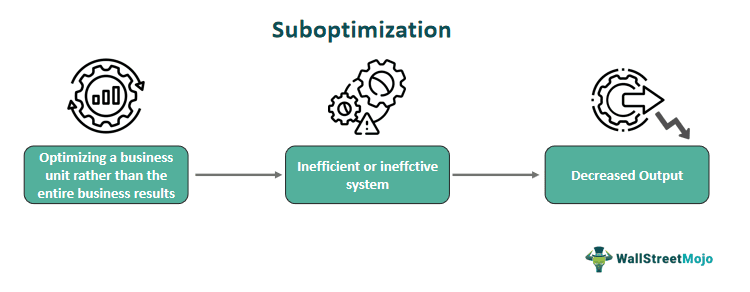Table Of Contents
Suboptimization Meaning
Suboptimization refers to a scenario where a system or organization operates below its optimal level due to inefficient or ineffective optimization of its components. This issue commonly arises from organizational silos, short-term orientations, and a deficiency in holistic thinking.

Addressing suboptimization underscores the significance of fostering open communication and collaboration among various organization segments. This ensures that decisions align with broader organizational goals, promoting overall efficiency. In essence, suboptimization highlights the necessity for a holistic approach to decision-making, emphasizing the consideration of individual decisions within the broader context of the entire system and organization.
Key Takeaways
- Suboptimization refers to the phenomenon where a system or process, instead of being optimized as a whole, is optimized only within its individual components or subparts.
- Suboptimization arises from a lack of holistic thinking and consideration of the broader context, leading to misaligned goals, siloed operations, and misaligned incentives.
- The problems of suboptimization occur when the focus on optimizing individual components leads to inefficiencies, wasted resources, and a lack of synergy across the organization.
- It involves optimizing a part of a system without considering the overall impact on the system as a whole. At the same time, optimization is the act of making the best or most effective use of a resource or system.
Suboptimization Explained
Suboptimization refers to the practice of fine-tuning or improving specific components of a process or model without considering the holistic performance. It occurs when decision-makers overlook the interconnectedness of various organizational components. They may focus on optimizing a specific process or department to boost efficiency without realizing that such gains can negatively impact other departments or the organization's overarching goals. This failure to consider the broader context results in the organization or system falling short of its full potential. The inefficiency arises when efforts concentrate on improving isolated aspects without accounting for the wider impact on the overall system or organization.
Noticing suboptimization is crucial for organizational success. It helps prevent inefficient use of resources, misaligned goals, and wasted efforts. Organizations can foster a holistic approach by identifying suboptimization, enhancing overall efficiency, and aligning individual efforts with broader objectives. Addressing suboptimization ensures that decisions contribute to the organization's long-term goals, promoting sustainability and optimal performance across all aspects of the business.
Causes
Several factors can contribute to the emergence of suboptimization:
- Misaligned Goals: When individual departments or teams have objectives that conflict with the broader organizational strategy, their actions may prioritize their success over the overall well-being of the organization. This misalignment can lead to competing interests and decisions that optimize one department at the expense of others.
- Communication Breakdown: Effective communication is the cornerstone of organizational synergy. When departments operate in silos, lacking open and transparent communication channels, they may make decisions based on incomplete or inaccurate information. This lack of visibility can lead to suboptimal solutions that fail to consider the needs and constraints of other departments.
- Incentive Misalignment: Reward and incentive structures are crucial in shaping employee behavior. Suppose incentives are designed to reward individual performance without considering the broader organizational context. In that case, employees may prioritize actions that benefit their own performance metrics, even if they come at the expense of overall organizational goals.
- Siloed Thinking: When departments or teams operate in isolation, focusing solely on their tasks and objectives, they may lose sight of the bigger picture. This siloed mentality can lead to inefficiencies, duplication of effort, and a lack of coordination, ultimately hindering the organization's ability to achieve its goals effectively.
Examples
Let us look at the suboptimization examples to understand the concept better –
Example #1
Suppose ABC Inc., a technology manufacturer, focused on suboptimization by heavily optimizing its manufacturing department to reduce production costs. While successfully cutting costs, this approach led to large production batches and an overflow of inventory. The surplus stock incurred higher holding costs and increased the risk of product obsolescence, ultimately impacting the overall efficiency of ABC's supply chain.
Example #2
Suppose XYZ Co. sought to optimize its distribution network by concentrating solely on minimizing transportation costs. The company achieved cost savings by consolidating shipments from suppliers to distribution centers. However, this suboptimization resulted in longer lead times, increased holding costs at distribution centers, and challenges in responding swiftly to changing customer demands. XYZ's exclusive focus on transportation costs without considering broader impacts affected the overall efficiency of its supply chain.
Effects
The consequences of suboptimization can be far-reaching and detrimental to an organization's success. It can lead to:
- Reduced Efficiency and Productivity: Suboptimized processes and workflows can result in wasted resources, duplicated efforts, and unnecessary delays, ultimately reducing overall productivity and efficiency.
- Hindered Goal Achievement: Suboptimization can prevent an organization from achieving its strategic goals and objectives. When individual departments prioritize their metrics over the broader organizational targets, aligning efforts and achieving the desired outcomes becomes difficult.
- Missed Opportunities and Stagnation: Suboptimization can limit an organization's ability to identify and capitalize on new opportunities for growth and innovation. By focusing on optimizing individual components in isolation, the organization may miss out on opportunities for cross-functional collaboration and synergy.
Suboptimization vs Optimization
The differences between suboptimization and optimization are as follows-
| Suboptimization | Optimization |
|---|---|
| Improving a specific part or department at the expense of the organization as a whole | Making the best or most effective use of a resource or system |
Achieving short-term gains or enhancing the performance of a specific area | Attaining long-term growth and maximizing the overall performance of the organization |
